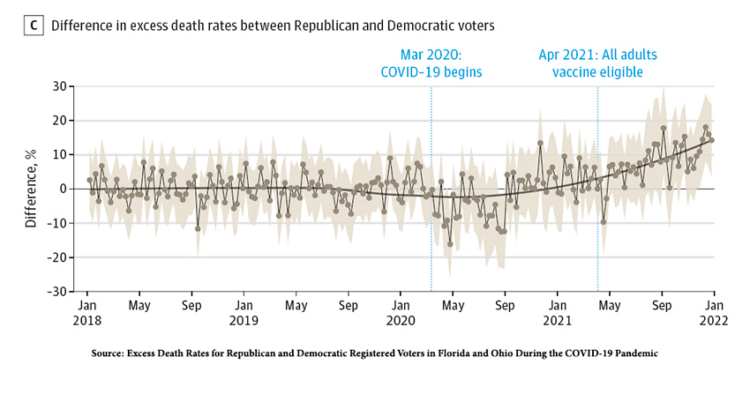The researchers collected weekly mortality data from January 2018 to December 2021 for individuals aged 25 or greater. They linked that mortality data with voter registration rolls in Florida and Ohio from 2017 (the only two states with historical voting records).
Excess deaths were calculated at the county level with a January 2018 to December 31, 2019 baseline and reflect the difference between death in the baseline period and from January 2020 to December 2021. The study considered more than 500,000 deaths in those two states over the entire period.
- There was a 20.5% increase in weekly deaths between March 2020 and December 2021
- Before the pandemic, there were “small fluctuations in excess death rates around 0 for both Republicans and Democrats.
- In the early stages of COVID, the winter of 2020, both Democrats and Republicans “experienced sharp increases of similar magnitude in excess death rates. That would change after vaccines became widely available
- The gap in excess deaths rose from a 0.9% difference (with more Republican deaths) to a 7.7% difference (again with more Republican deaths) by March 2021

- When stratified by age, there were no significant differences in those 25 to 64. Democrats had higher excess death rates in the 64 to 75-year age group. [1]
- Most of the Republican deaths were in Ohio, “with smaller, and generally nonsignificant, differences in weekly excess death rates between Republican and Democratic voters in Florida.
Republican voters had higher excess death rates than Democratic voters, as noted in a large mortality gap in the period after, but not before, all adults were eligible for vaccines in Florida and Ohio. With adjustments for differences in age and state of residence between Republican and Democratic voters, our findings suggest that, among individuals in the same age groups living in the same states, there were significant differences in excess death rates during the COVID-19 pandemic associated with political party affiliation.
There are several possibilities to explain this discrepancy. It is possible, but very unlikely, that Republicans have some underlying increased biological susceptibility. It is more likely that the political party serves as a “Big Tent” proxy for underlying medical conditions, socioeconomic status, and health insurance. It may also be equally as likely that Republican behavior, more explicitly ignoring public health measures, both pharmacologic and not, also was an important driver. It is equally important to mention that whatever the underlying reason, it did not seem to impact those between 25 and 64.
Notes:
[1] There is an entanglement of age and party affiliation. According to a Pew study of 2020 voters those 65 or older are slightly more likely to be Republican (25% vs. 23%).Dr. Charles Dinerstein, M.D., MBA, FACS is the Medical Director at the American Council on Science and Health. He has over 25 years of experience as a vascular surgeon. He completed his MBA with distinction in the George Washington University Healthcare MBA program and has served as a consultant to hospitals. Follow Charles on X @CRDtoday
A version of this article was originally posted at American Council on Science and Health and has been reposted here with permission. Any reposting should credit the original author and provide links to both the GLP and the original article. Find ACSH on X @ACSHorg































